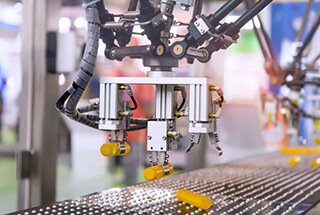
Ever wondered why your CNC milling machine vibrates and ruins your precision? This article explores twelve expert tips to minimize cutting vibrations, from using sharp inserts to optimizing cutting parameters. By applying these strategies, you’ll achieve smoother operations, better surface finishes, and extended tool life. Read on to discover how to enhance your machining processes and ensure your CNC milling machine performs at its best.

01
Sharp inserts can significantly reduce cutting forces in CNC milling operations.
Inserts are available in both coated and uncoated varieties. Uncoated inserts typically offer superior sharpness compared to their coated counterparts. This is due to the fact that coated inserts require edge passivation (ER-treatment) prior to coating application. The passivation process slightly dulls the cutting edge to ensure proper coating adhesion, as extremely sharp edges can compromise the bond strength of the coating at the cutting interface.
02
When machining to a specific depth, utilizing inserts with a small tip radius can substantially decrease cutting forces, particularly in the radial direction.
Radial cutting forces are the primary cause of vibrations in slender tools or workpieces. This principle applies to both turning and milling operations. As the tip radius increases, there is a greater tendency for slender tools or workpieces to vibrate at a given cutting depth.
03
When selecting the depth of cut, it is crucial to avoid setting it equal to the tool tip’s arc radius. This configuration can lead to unstable cutting conditions and increased vibration.
04
For keyway cutting with slender tool shanks or external turning of slender shafts, utilizing a tool with a 90° primary angle (approach angle) is advantageous in minimizing vibrations.
In both scenarios – external turning of a slender shaft or keyway cutting with a slender tool holder – a 90° tool generates the lowest radial cutting force while producing the highest axial force at the cutting edge. This force distribution helps to stabilize the cutting process and reduce vibration.
05
For milling operations using slenders tools, round insert cutters are most effective in mitigating vibrations.
The behavior of milling cutters contrasts with that of turning tools. In milling, as the approach angle nears 90°, the radial cutting force increases, leading to greater tool shank vibration. Round insert cutters, with their gradually changing engagement angle, help to distribute cutting forces more evenly and reduce vibration.
06
When using slender end mills for deep cavity milling on CNC machines, plunge milling is often employed. This technique involves axial feeding of the tool, similar to drilling, when machining deep cavities.
For tools with an overhang greater than 3 times their diameter, axial feed plunge milling is recommended to minimize deflection and vibration. However, it’s important to note that end mill inserts have a limited radial cutting edge width.
Tool manufacturers provide technical data specifying the maximum allowable width of cut when using plunge milling techniques. Adhering to these recommendations is crucial for optimal performance and tool life.
07
When milling thin-walled workpieces, such as box or bowl-shaped parts, vibration primarily originates from the workpiece itself rather than the cutting tool.
Given that the vibration source is the workpiece, the primary focus for successful machining of such components should be on enhancing workpiece clamping and support. Strategies may include using custom fixtures, additional support structures, or damping materials to increase workpiece rigidity during machining.
08
For boring operations, a smaller lead angle (complement of the tool’s approach angle) is generally preferable.
This configuration results in a larger trailing angle, which reduces the contact area between the secondary cutting edge and the machined surface. This decreased contact minimizes the likelihood of chatter developing into sustained vibration. Additionally, a smaller lead angle reduces the probability of chip compression by the secondary cutting edge, further enhancing cutting stability.
09
Utilizing a face milling cutter with unequal pitch and fewer teeth can effectively reduce milling vibrations.
In this context, “teeth” refer to the cutting inserts. For example, a 100mm diameter face mill with 5 inserts will generate approximately 50% less cutting force compared to a 10-insert cutter, assuming all other cutting parameters are equal. The unequal pitch disrupts the harmonic formation of vibrations, while fewer teeth reduce the overall cutting force, both contributing to more stable machining.
10
Employ inserts with large positive rake angles and a light chip breaker design.
Such inserts feature a smaller cutting wedge angle during machining operations, resulting in lower cutting forces and improved chip evacuation. This configuration enables lighter and faster cutting, which can help mitigate vibration issues, especially in finishing operations.
11
Fine-tuning cutting parameters can be effective in reducing mild vibration issues.
General adjustment strategies include:
For internal thread turning operations experiencing vibration, reducing the infeed increment for the final passes by 1 or 2 cuts can often improve stability.
12
Optimizing the toolpath is crucial for successful milling operations, particularly in vibration-prone scenarios.
The choice between conventional (up) and climb (down) milling can impact vibration. Traditional milling theory suggests that conventional milling reduces vibration, primarily due to its ability to dampen vibrations caused by backlash in machine tool leadcscrews. However, with modern CNC machines utilizing precision ball or roller screws, this effect is minimal.
In practice, whether employing climb or conventional milling, the key factor in reducing vibration for flexible workpieces is aligning the milling force direction with the workpiece clamping direction. This approach helps to seat the workpiece firmly against its supports, minimizing potential vibration in thin or compliant parts.








